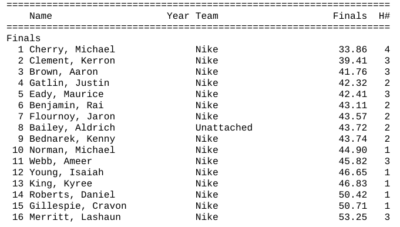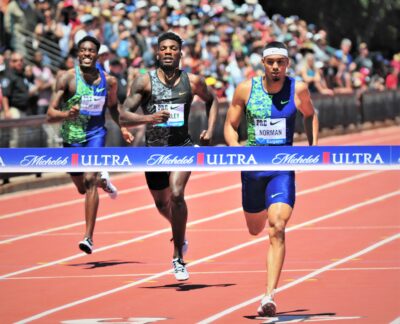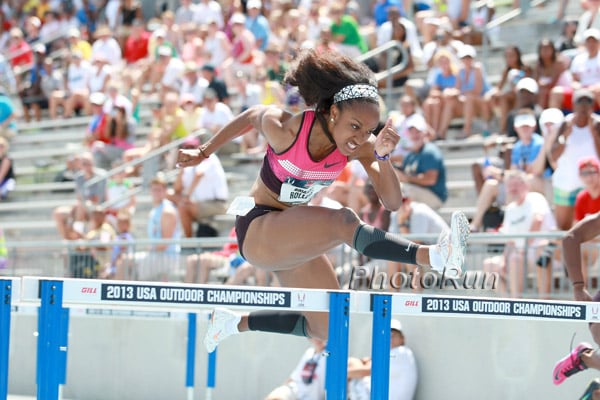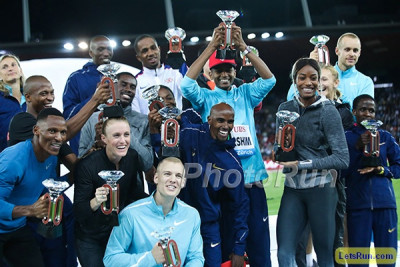Why Did Michael Norman Run 9.86 — And Then Race Four More Times? A Look at How COVID-19 Is Affecting Elite Track & Field Contracts
By Jonathan Gault
July 22, 2020
On Monday afternoon, Michael Norman tweeted out a video of himself running a 100-meter dash earlier that day in Fort Worth, Tex. Though the video was decidedly amateur and Norman hard to pick out at first — he traded his trademark headband for a new quarantine-do — the caption told us all we needed to know: Norman had run a wind-legal 9.86 seconds for 100 meters.
Immediately, track Twitter blew up. Norman’s huge personal best would have ranked him #2 in the world last year in the 100 and immediately thrust him into the conversation of history’s most versatile sprinters. He is the only man in history to have broken 9.90 for 100 and 44.00 for 400. This was all very exciting.
Not as exciting: the other four races Norman ran on Monday. For some reason, Norman neglected to tweet out evidence of himself running 150 meters in 18.89 seconds or 250 meters in 34.82 seconds or 300 meters in 44.90 — over a second slower than his 400-meter personal best.
Norman’s day at the AP Ranch High Performance Invitationals (yes, plural — we’ll get to that) was the latest example of track & field’s ability to both astound and confound. On the same day as one of the sport’s most thrilling young athletes produced one of the best performances of the year, he had to jog a few “races” at strange distances to fulfill contractual obligations. Why, exactly, this had to happen shines a light on the odd situation in which many sponsored athletes find themselves in this oddest of track & field seasons.
The first thing to understand: many track & field contracts require an athlete to compete a certain number of times per year or risk having their base pay reduced the following year. It’s pretty standard stuff: if a brand is paying an athlete to endorse their product, they want to ensure the athlete is out there doing that at competitions.
“It’s more of an inactivity clause because they want to encourage you to compete,” says agent Ray Flynn. “I think that’s a reasonable requirement.”
In a normal year, this requirement wouldn’t be an issue for a healthy athlete. But in 2020, with competition opportunities scarce, it’s taken on new importance. Shoe brands, like everyone else, have taken a revenue hit as a result of the coronavirus pandemic and are looking to save money where possible. One way to do that is through the use of reduction clauses — clauses placed in an athlete’s contract that allow a brand to reduce their pay should they fail to hit certain benchmarks.
 FYI, most of these 300m times are pretty mediocre
FYI, most of these 300m times are pretty mediocre
The problem? It’s unclear whether those traditional benchmarks would be enforceable this year. A common benchmark: an athlete is reduced for failing to make the Olympic team. It would seem particularly cruel (and perhaps illegal) for a brand to enforce that reduction in a year without an Olympics. But failing to compete a certain number of times is a reduction that could be enforced.
Athletes, naturally, do not want to be reduced. But how does one compete 10 times (the magic number for many Nike athletes) in a year in which the majority of meets have been cancelled? Get creative.
Study the results of Monday’s races closely and you’ll notice what appeared to be one meet was actually five. The long jump and 60 meters were part of “AP Ranch HP Invitational #1.” The 100 meters was the only event in a separate meet: “AP Ranch HP Invitational #2.” The 150 meters was part of “AP Ranch HP Invitational #3.” NTX Timing’s website lists five more “meets” for Thursday, with events ranging from 60 meters to 400 meters. Norman is entered in all five of them. And that’s how you knock out 10 competitions in four days.
Let’s straighten a few things out here. First, none of this is Norman’s fault. He delivered one of the most electrifying performances of 2020; no one will blame him for going through the motions in a few other races that weren’t even televised.
He was also hardly alone. In all, 14 men and 11 women — all sponsored by Nike (or the Nike-owned Jordan Brand, in the case of Kori Carter) — ran the same quintuple as Norman. And though there were some standout performances — in addition to Norman, 400 hurdler hurdler Rai Benjamin ran an impressive 10.03 in the 100, while 100-meter hurdler Olympic champ Brianna Rollins-McNeal clocked a world best of 16.41 for 150 meters — many of them were downright ordinary. Or, in the case of LaShawn Merritt‘s 53.25 300m (a gentlemanly three-quarter lap stroll at 4:45 mile pace), worse than ordinary.
Second: while they’ve had their issues recently, Nike running sports marketing executives aren’t the bad guys here. While reduction clauses exist in almost every Nike contract, they are not always enforced. Multiple industry sources said they believe the decisions about whether to reduce athletes at the end of 2020 in an attempt to save money would come from elsewhere within Nike — not the individuals usually charged with handling track & field sponsorships.
“Nike sports marketing are trying to prevent the athletes from losing money,” says one industry source, who requested anonymity. “They were actually very instrumental in setting up those Texas meets…It’s so stupid that we have to do this, but at the same time, we had to do what we had do to [ensure] these athletes [weren’t] reduced.”
LetsRun.com reached out to Nike for this story but had not heard back as of publication.
In general, Flynn says, he believes brands have treated athletes well during the pandemic and believes athletes need to do what they can to deliver value this year.
“Athletes need to make best effort to compete where they can,” says Flynn, whose client Ameer Webb competed in the Texas meet on Monday. “If you can, you should. I think that’s reasonable…I give credit to those coaches setting up that meet [Monday].”
Where it all gets silly, though, is the minimum-race requirement. In the end, it doesn’t really matter if Michael Norman jogs a few extra races after running a 9.86. But who does it benefit? Not him. And not Nike, who gains zero additional exposure.
Also consider: does it make sense for an athlete like Kenny Bednarek — who did not produce a single noteworthy performances in his five races Monday — to travel to Texas from his training base in the coronavirus hotspot of Florida just to put some times on paper to ensure his livelihood? Because that’s what just happened.
Relaxing or eliminating minimum competition requirements in 2020 is the common-sense solution. Whether the decisionmakers at Nike and the other brands will realize this remains to be seen.
***
Looking to 2021, uncertainty looms over the sport
Track & field operates in Olympic cycles, and everyone went into 2020 believing it to be an Olympic year. Which means that, across the sport, a lot of contracts are coming up for renewal.
“About 80% of my athletes’ contracts expire December 31,” says Paul Doyle, whose clients including reigning Olympic champions Christian Taylor and Ryan Crouser.
Flynn estimated the number was lower for his clients — perhaps 25-30% — but the question of what happens to those athletes whose deals are up at the end of year is one that hangs over the industry. And right now, no one seems to know.
“I’d like to see the whole industry rebound quite a bit over the next few months so when we start to have these discussions, the athletes are in a better negotiating position and the companies will have bigger budgets,” Doyle says. “We all need to be patient still and see where things pan out and see where things stand in September. Because I don’t think the companies have a clue what their budgets are going to be even a few months from now.”
However, Doyle says that if the industry doesn’t rebound, the sport’s landscape could look drastically different next year.
“The gross amount of money in the sport today vs. January 2021, we could be looking at a sport-wide reduction of 50%. And it’s going to be at all levels — not just the shoe contracts, but the competitions and the sponsorships of events. You see the Diamond League events trying to survive this year — their sponsorships decreased and their prize money is cut in half.”
Individual athlete contracts expire every year, and the criteria brands use to decide whether to offer a new deal isn’t changing. Performances to date, marketability, and Olympic and World Championship potential have always been important and always will be. But there has never been more uncertainty in the sport, from shoe company budgets to the possibility that the Olympics — already postponed to 2021 — may be canceled entirely. Agent Chris Layne, managing director of Total Sports, whose clients include Shelby Houlihan and Morgan McDonald, says contract decisions will be particularly tough this year.
“I can envision shoe companies wanting to and needing to get creative and perhaps looking at some of these contracts and trying to figure out how they can re-sign athletes and perhaps terms are different than they would be in a normal year,” Layne says. “I see creative times on the horizon. I think there are going to be some really, unique, creative situations evolve from all of this. And don’t think it’s just going to be the shoe companies. I would imagine that coaches are going to have to look at their groups, I would imagine that agents are going to have to look at their groups and really take a hard look at becoming efficient in very difficult times.”










